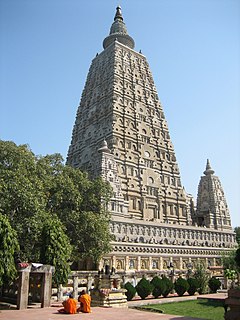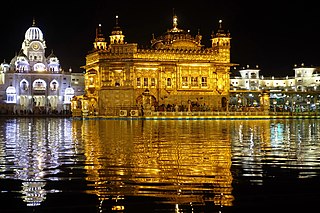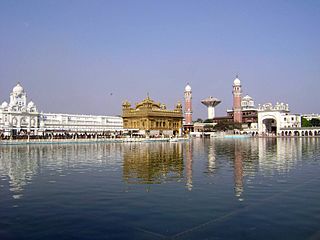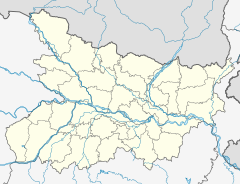A gurdwara is a place of assembly and worship for Sikhs. Sikhs also refer to gurdwaras as Gurdwara Sahib. People from all faiths are welcomed in gurdwaras. Each gurdwara has a Darbar Sahib where the current and everlasting guru of the Sikhs, the scripture Guru Granth Sahib, is placed on a takhat in a prominent central position. The raagis recite, sing, and explain the verses from the Guru Granth Sahib, in the presence of the congregation.

The name "Dasam Granth", is given to a collection of various manuscripts in Sikhism containing compositions attributed to Guru Gobind Singh. It is a sacred text and not a secondary to the Guru Granth Sahib. Guru Gobind Singh ordained the sacred text Guru Granth Sahib as his successor, eternally ending the line of human Gurus. It is the only holy scripture of the Sikhs and regarded by Sikhs as the living embodiment of Ten Gurus. Bachiter Natak is a part of composition
The Takht Sri Darbar Sahib Damdama Sahib, one of the five Takhts or Seat of Temporal Authority of Sikhism, Takht Sri Damdama Sahib is in Bathinda in Punjab, India and is the place where Guru Gobind Singh, the tenth Sikh Guru, prepared the full version of the Sikh scriptures called Sri Guru Granth Sahib in 1705. The other four Takhts are the Akal Takht, Takht Sri Keshgarh Sahib, Takht Sri Patna Sahib and Takht Sri Hazur Sahib.

Takht Sri Patna Sahib also known as Harmandir Sahib, is a Gurdwara in the neighbourhood of Patna Sahib, India. It was to commemorate the birthplace of Guru Gobind Singh, the tenth Guru of the Sikhs on December 1666. It was built by Maharaja Ranjit Singh (1780-1839), the first Maharaja of the Sikh Empire, who also built many other Gurdwaras in the Indian subcontinent. The current shrine of Patna Sahib or Takht Sri Harmandirji Sahib was built in the 1950s.

The Sarbloh Granth, also called Manglacharan Puran or Sri Manglacharan Ji, is a voluminous scripture, composed of more than 6,500 poetic stanzas. It is considered as an amalgamation of writings of Guru Gobind Singh and other poets.

The principal Sikh scripture is the Adi Granth, more commonly called the Guru Granth Sahib. The second most important scripture of the Sikhs is the Dasam Granth. Both of these consists of text which was written or authorised by the Sikh Gurus.

Sikh Architecture is a style of architecture that is characterized with values of progressiveness, exquisite intricacy, austere beauty and logical flowing lines. Due to its progressive style, it is constantly evolving into many newly developing branches with new contemporary styles. Although Sikh architecture was initially developed within Sikhism its style has been used in many non-religious buildings due to its beauty. 300 years ago, Sikh architecture was distinguished for its many curves and straight lines; Shri Keshgarh Sahib and the Sri Harmandir Sahib are prime examples.

Chandi di Var is a composition written by Guru Gobind Singh, included in the 5th chapter of Dasam Granth. It is based on an episode from the Sanskrit work Markandeya Purana, and describes the conflict between the Gods and the Demons. In the ballad, the supreme goddess is transformed into a liberating divine power in the form of sword, that crushes perpetuators of falsehood.

Gurdwara Handi Sahib is situated in Danapur is a cantonment station, 20 km west of old Patna City. Guru Tegh Bahadur had returned to Punjab in April 1670 leaving his family behind at Patna. The family after leaving Patna Sahib made their first halt here. An old lady named Jamani Mai served a kettleful (handi) of khichari to them after which the shrine subsequently built here was named as Handiwali Sangat, which is now called Gurdwara handi Sahib. Son of Mata jamni Mai Mathura Singh donated the land on which gurudwara was built and his family members still live there under guardianship of Sri Arun Singh, still rendering services inherited by his great grand fathers.

Gurdwara Sri Guru Gobind Singh Ghat, also known as Gurudwara Kangan Ghat, is a Sikh place of worship on the banks of the Ganges River approximately 650 m (710 yd) from Takht Sri Patna Sahib. In Hindu mythology, this is the place where Guru Gobind Singh threw his gold bangle (kangan) and passed on the knowledge of Sri Guru Granth Sahib Ji to Pandit Shiv Dutt, a devotee of Sri Ram Chandra. This myth is not accepted by Sikhs as it violates the Sikh faith's disbelief in miracles. Knowledge cannot be passed in this manner
About three kilometers east of Takht Sri Harmandir Sahib is where Guru Tegh Bahadur first alighted in a garden (bagh) belonging to Nawabs Rahim Bakhsh and Karim Bakhsh, nobles of Patna, and where the sangat of Patna along with the young Guru Gobind Singh came out to receive him back from his four-year-long odyssey. A shrine commemorative of the first meeting of Tegh Bahadur and Gobind Singh was established here. Its present building was constructed during the 1970s and 1980s. An old well which is still in use and a dried stump of the Imli tree under which the sangat met Guru Tegh Bahadur still exists.

Bihar in eastern India is one of the oldest inhabited places in the world with a history going back 3000 years. The rich culture and heritage of Bihar is evident from the innumerable ancient monuments that are dotted all over the state. Bihar is home to many tourist attractions and is visited by large numbers of tourists from all over the world. Around total 6 million tourists visit Bihar every year.
The main religions in the Indian state of Bihar are Hinduism and Islam (16.9%) as of 2011. Other religions are practiced by small minorities. Places in Bihar have important historical and cultural associations with Buddhism, Sikhism and Jainism along with Hinduism.

The Golden Temple, also known as Harmandir Sahib, meaning "abode of God" or Darbār Sahib, meaning "exalted court", is a gurdwara located in the city of Amritsar, Punjab, India. It is the preeminent spiritual site of Sikhism.

Hazur Sahib, also known as Takht Sachkhand Sri Hazur Abchalnagar Sahib, is one of the five takhts in Sikhism. It is located on the banks of the Godavari River at the city of Nanded in the state of Maharashtra, India. The gurdwara within the complex is known as Sach-Khand.

A takht, or taḵẖata literally means a throne or seat of authority and is a spiritual and temporal centre of Sikhism. There are five Takhts, which are five gurudwaras that have a very special significance for the Sikh community. The first and the most important was established by Guru Hargobind in 1609, 'Akal Takht' and is just opposite the gate of Harmandir Sahib – The Golden Temple, Amritsar. While the Harmandir Sahib, or Golden Temple, represents Sikh spiritual guidance, the Akal Takht symbolizes the dispensing of justice and temporal activity. It is the highest seat of temporal authority of the Khalsa and the seat of the Sikh religion's earthly authority. There, the Guru held his court and decided matters of military strategy and political policy. Later on, the Sikh Nation took decisions here on matters of peace and war and settled disputes between the various Sikh groups. The Sarangi singers sung the ballads of the Sikh Gurus and warriors at the place and robes of honour (saropas) were awarded to persons who rendered distinguished services of the community of men in general. In December 2010, the Deccan Odyssey train, taken on charter from Government of Maharashtra, started with the aim to have a journey across four Sikh takhts, with a flight by devout and sightseers to the fifth takht. A special train named Panj Takht Special train for the pilgrimage of five Sikh takhts, was flagged off on 16 February 2014.

Patna City, popularly known as Patna Saheb or Patna Sahib, is a neighbourhood in Patna, Bihar, India. It is regarded as very sacred by the Sikhs in India. The tenth Guru of the Sikhs, Guru Gobind Singh was born there. The Patna Saheb Gurudwara is considered to be one of the holiest of the five "Takhts" or seat of authority of the Sikhs. The place is named Harminder Takht though the Sikhs respectfully call it Patna Sahib. The famous Guru Gobind Sahib Gurudwara is an important shrine for Sikhs from all over the world. Ashok Rajpath (road) connects Patna City to Patna.

The 350th Prakash Parv or birth anniversary of Guru Gobind Singh ji was celebrated in January 2017 in Patna, India. 2017 is the year of the 350th anniversary of the 10th Sikh Guru, a spiritual master, warrior, poet and philosopher. At the date of this anniversary, a number of events was organized on the occasion in Patna marking a grand celebration in their history.











